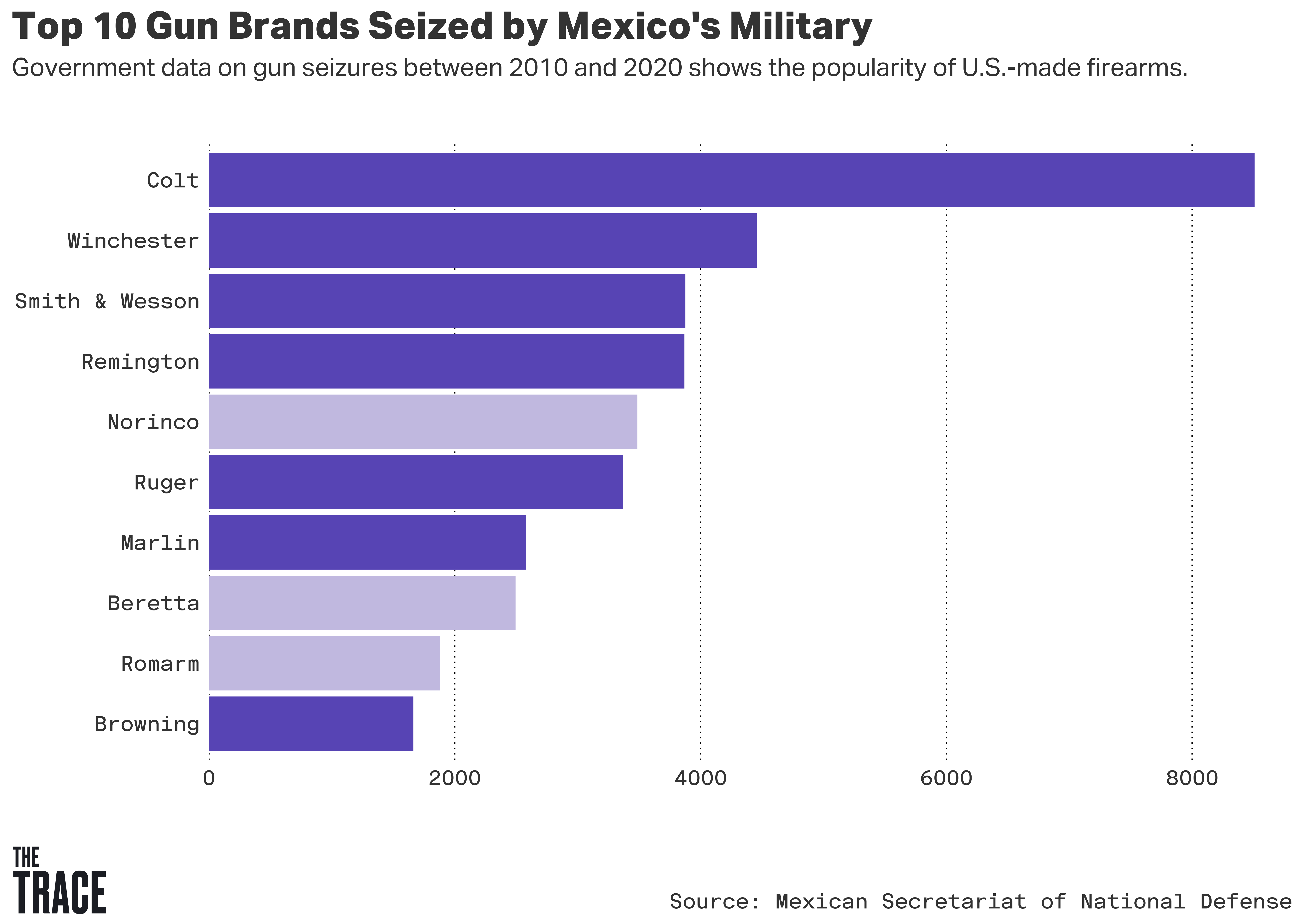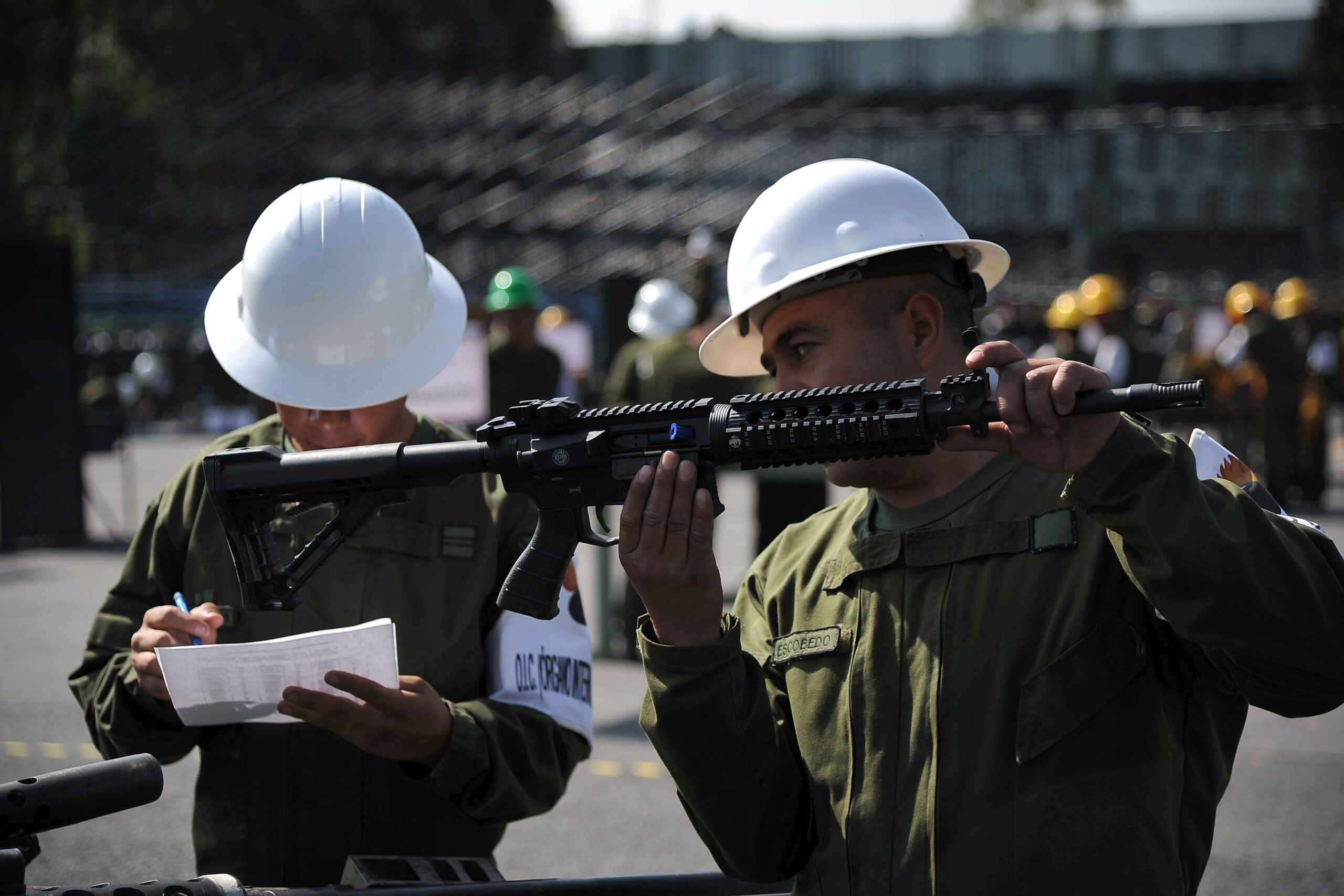On September 30, a federal judge dismissed a groundbreaking legal challenge to the gun industry filed by the government of Mexico. The suit laid out an argument that major U.S. gunmakers have knowingly facilitated more than a decade of deadly cartel violence across the southern border. They have done this, Mexico argued, by marketing weapons in a way that attracts criminals and turning a blind eye to those weapons’ diversion into trafficking routes. The judge dismissed the claim on account of a special legal shield enjoyed by the gun industry.
To date, data underlying Mexico’s dramatic pronouncements — that as much as 90 percent of all guns recovered on Mexican soil originated in the U.S.; that as many as 597,000 weapons slip over the border each year, most from American gun manufacturers — has only been shared in aggregate form by the Bureau of Alcohol, Tobacco, Firearms and Explosives.
But data obtained from Mexico’s Secretariat of National Defense provides a detailed look at the specific manufacturers who produce weapons commonly used in cartel violence. The data details every firearm recovered by the Mexican military between 2010 and May of 2020 — almost 125,000 weapons, including machine guns, grenade launchers, and tens of thousands of pistols and rifles. Taken together, the numbers tell a damning story of iconic American gunmakers’ involvement in a decade of Mexican bloodshed.
U.S. gun manufacturers make up seven out of the top 10 companies whose guns are most frequently seized by the Mexican military. Colt Manufacturing, based in Hartford, Connecticut, led the list, with more than 8,500 firearms — 6.8 percent of all guns recovered in Mexico over the 10-year span. Winchester Repeating Arms, based in New Haven, Connecticut, followed in second place with over 4,000 weapons recovered. Major gunmakers including Smith & Wesson, Remington, Ruger, and Browning, also appear in the top 10.

Altogether, U.S. weapons manufacturers accounted for at least 30 percent of guns in the dataset, according to a Trace analysis. Another 61,000 guns — roughly half of all the weapons recovered — either had no identifiable manufacturing marks, or had their manufacturer information left out during data entry. It’s possible many of these guns originated in the U.S., but had identifying characteristics scratched away by their owners in attempts to evade tracking by authorities. (Like U.S. police agencies, the Mexican government traces firearms with the ATF.)
It is also possible that many of the guns manufactured by foreign-based gun companies originated in the U.S. Glock, an Austrian company, has a separate operation headquartered in Georgia. Sig Sauer, a German company, has headquarters in New Hampshire. These companies, along with several others, manufacture and sell millions of guns domestically every year. The Mexican military’s data shows that 970 Glock firearms were recovered in the country between 2010 and 2020. But because the data does not specify the country in which each gun was manufactured, guns produced by foreign companies were excluded from The Trace’s estimates of U.S.-made guns. ATF trace data, which may include some subset of these firearms, as well as recoveries made by law enforcement authorities other than the Mexican military, shows that more than 70,000 guns made their way from the U.S. to Mexico between 2015 and 2020.
Mexico enforces extremely stringent gun laws. There is only one gun store in the entire country, and it’s located behind fortified walls on a military base. Anybody interested in purchasing a gun from this store must undergo months of background scrutiny. Law enforcement and border security experts have long recognized that these restrictions — paired with a thriving array of cartels warring for regional power — make Mexico a hot destination for trafficked firearms. The country’s proximity to the U.S and the sheer abundance of guns in circulation here make the U.S. a natural source.
“We produce some of the best firearms in the world,” said David Shirk, a professor of political science at the University of San Diego who specializes in U.S.-Mexico relations. “Some of the people who are most interested in obtaining firearms and with the most financial resources to do so are Mexican drug trafficking and criminal organizations.”
The human cost of this black market transaction is extraordinary: The Mexican government claims that more than 180,000 people were killed in violent gun crimes between 2007 and 2019, spinning an unfathomable web of grief and forcing many to flee their homes. The violence in certain areas is so extreme that the U.S. Department of State has advised travelers to avoid them.
This death toll has become a political sticking point for the administration of Mexico’s current president, Andrés Manuel López Obrador. Where previous administrations have tried to snuff out cartel activity by force, Obrador has tried to shift some of this focus to root causes: socioeconomic struggles that make cartel involvement appealing to young men, and arms trafficked over the country’s northern border. It was in step with this strategy that Mexico launched its lawsuit against U.S. gun companies in 2021.
“[The manufacturers] should make necessary changes so they are not appealing to narcos,” said Alejandro Celorio Alcántara, a legal advisor for Mexico’s Foreign Ministry who was intimately involved with the country’s lawsuit. “They have access to trace information.”
Domestically, countering arms trafficked from the U.S. has been of second mind to policy makers, who have tended instead to focus on drugs and people being trafficked north. But some efforts to clamp down on southbound gun trafficking routes have picked up steam in Congress. Most recently, in June, the U.S. Congress passed the Bipartisan Safer Communities Act, which makes straw purchasing and gun trafficking federal crimes.
Law enforcement experts say it’s dangerous to underestimate the integral role firearms play in driving both drugs and people north.
“Tens of thousands of people are dying from fentanyl overdoses every year in the U.S, and most of that fentanyl these days is coming directly from Mexico, from the cartels,” said Joseph Lestrange, a retired Homeland Security Investigations division chief, who is now a security consultant, adding that U.S. guns arm most of the cartels sending these drugs north. “[Gun trafficking] fuels and facilitates the continued expansion of criminal enterprises in Mexico that are feeding this demand.”

